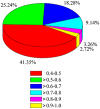Exploration of gene functions for esophageal squamous cell carcinoma using network-based guilt by association principle
- PMID: 29694510
- PMCID: PMC5937724
- DOI: 10.1590/1414-431x20186801
Exploration of gene functions for esophageal squamous cell carcinoma using network-based guilt by association principle
Abstract
Gene networks have been broadly used to predict gene functions based on guilt by association (GBA) principle. Thus, in order to better understand the molecular mechanisms of esophageal squamous cell carcinoma (ESCC), our study was designed to use a network-based GBA method to identify the optimal gene functions for ESCC. To identify genomic bio-signatures for ESCC, microarray data of GSE20347 were first downloaded from a public functional genomics data repository of Gene Expression Omnibus database. Then, differentially expressed genes (DEGs) between ESCC patients and controls were identified using the LIMMA method. Afterwards, construction of differential co-expression network (DCN) was performed relying on DEGs, followed by gene ontology (GO) enrichment analysis based on a known confirmed database and DEGs. Eventually, the optimal gene functions were predicted using GBA algorithm based on the area under the curve (AUC) for each GO term. Overall, 43 DEGs and 67 GO terms were gained for subsequent analysis. GBA predictions demonstrated that 13 GO functions with AUC>0.7 had a good classification ability. Significantly, 6 out of 13 GO terms yielded AUC>0.8, which were determined as the optimal gene functions. Interestingly, there were two GO categories with AUC>0.9, which included cell cycle checkpoint (AUC=0.91648), and mitotic sister chromatid segregation (AUC=0.91597). Our findings highlight the clinical implications of cell cycle checkpoint and mitotic sister chromatid segregation in ESCC progression and provide the molecular foundation for developing therapeutic targets.
Figures




Similar articles
-
Ranking candidate genes of esophageal squamous cell carcinomas based on differentially expressed genes and the topological properties of the co-expression network.Eur J Med Res. 2014 Oct 29;19(1):52. doi: 10.1186/s40001-014-0052-x. Eur J Med Res. 2014. Retraction in: Eur J Med Res. 2015 Mar 26;20:37. doi: 10.1186/s40001-015-0130-8. PMID: 25358439 Free PMC article. Retracted.
-
Bioinformatics analysis of gene expression profiles of esophageal squamous cell carcinoma.Dis Esophagus. 2017 May 1;30(5):1-8. doi: 10.1093/dote/dow018. Dis Esophagus. 2017. PMID: 28375447
-
Network‑based gene function inference method to predict optimal gene functions associated with fetal growth restriction.Mol Med Rep. 2018 Sep;18(3):3003-3010. doi: 10.3892/mmr.2018.9232. Epub 2018 Jun 29. Mol Med Rep. 2018. PMID: 30015878
-
Integrated Bioinformatics Analysis Identifies Hub Genes Associated with the Pathogenesis and Prognosis of Esophageal Squamous Cell Carcinoma.Biomed Res Int. 2019 Dec 26;2019:2615921. doi: 10.1155/2019/2615921. eCollection 2019. Biomed Res Int. 2019. PMID: 31950035 Free PMC article.
-
Prediction of optimal gene functions for osteosarcoma using network-based- guilt by association method based on gene oncology and microarray profile.J Bone Oncol. 2017 Apr 8;7:18-22. doi: 10.1016/j.jbo.2017.04.003. eCollection 2017 Jun. J Bone Oncol. 2017. PMID: 28443230 Free PMC article.
Cited by
-
Identification of Important Invasion-Related Genes in Non-functional Pituitary Adenomas.J Mol Neurosci. 2019 Aug;68(4):565-589. doi: 10.1007/s12031-019-01318-8. Epub 2019 Apr 13. J Mol Neurosci. 2019. PMID: 30982163
-
An insight into the potential role of LINC00968 in luminal breast cancer: Case-control study and bioinformatics analysis.Biochem Biophys Rep. 2023 Aug 21;35:101531. doi: 10.1016/j.bbrep.2023.101531. eCollection 2023 Sep. Biochem Biophys Rep. 2023. PMID: 37654678 Free PMC article.
-
Esophageal chemical burns as a risk factor for esophageal malignancies: in-silico analyses - experimental research.Ann Med Surg (Lond). 2024 Jun 24;86(9):5170-5178. doi: 10.1097/MS9.0000000000002317. eCollection 2024 Sep. Ann Med Surg (Lond). 2024. PMID: 39239040 Free PMC article.
References
-
- Wong GS. Periostin and its role in promoting invasion in the tumor microenvironment of esophageal cancer. University of Pennsylvania, ProQuest Dissertations Publishing; 2012. p. 3551813.
MeSH terms
LinkOut - more resources
Full Text Sources
Other Literature Sources
Medical
Miscellaneous

